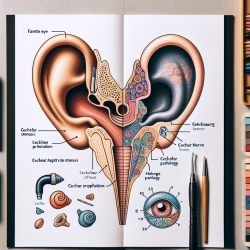Introduction
In the realm of pediatric audiology, congenital unilateral sensorineural hearing loss (USNHL) presents unique challenges and opportunities for intervention. The study titled "Correlation of cochlear aperture stenosis with cochlear nerve deficiency in congenital unilateral hearing loss and prognostic relevance for cochlear implantation" provides critical insights into the anatomical features associated with USNHL and their implications for cochlear implantation.
Key Findings from the Study
The study conducted a retrospective chart review of 39 children with congenital, non-syndromic USNHL. The research identified significant inner ear anomalies in 46% of the subjects, with cochlear nerve deficiency (CND) being the most prevalent defect, often associated with cochlear aperture (CA) stenosis. Only a minority of cases exhibited internal auditory canal (IAC) stenosis.
These findings underscore the importance of comprehensive imaging, using both CT and MRI, to accurately diagnose and assess the extent of inner ear malformations. This dual approach allows practitioners to better predict which patients are likely to benefit from cochlear implants.
Implications for Practice
For practitioners, the study highlights the necessity of a thorough diagnostic work-up in children with USNHL. The presence of CND and CA stenosis can significantly impact the decision-making process regarding cochlear implantation. Here are some practical steps for clinicians:
- Utilize both CT and MRI imaging to assess the inner ear structures comprehensively.
- Engage in shared decision-making with families, providing detailed counseling about the potential outcomes of cochlear implantation.
- Consider the anatomical and functional status of the cochlear nerve when evaluating candidates for cochlear implants.
Encouraging Further Research
While the study provides valuable insights, it also opens avenues for further research. Future studies could explore the genetic underpinnings of these malformations and their correlation with hearing outcomes post-implantation. Additionally, larger, multi-center studies could provide more robust data to guide clinical decisions.
Conclusion
The correlation between cochlear aperture stenosis and cochlear nerve deficiency in USNHL is a critical consideration in the management of this condition. By integrating these findings into clinical practice, practitioners can enhance the precision of their interventions, ultimately improving outcomes for children with USNHL.
To read the original research paper, please follow this link: Correlation of cochlear aperture stenosis with cochlear nerve deficiency in congenital unilateral hearing loss and prognostic relevance for cochlear implantation.










